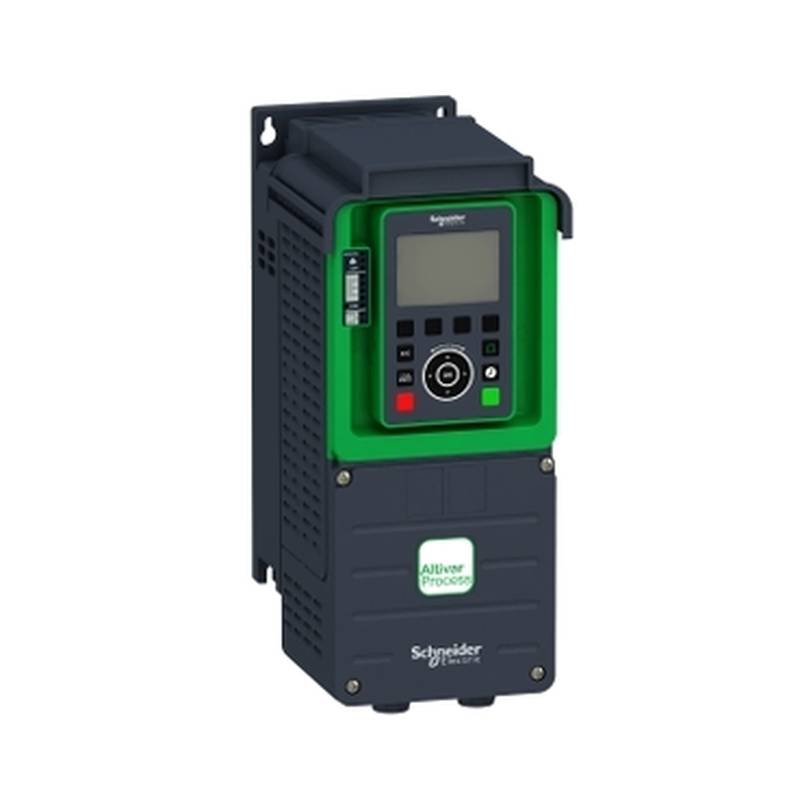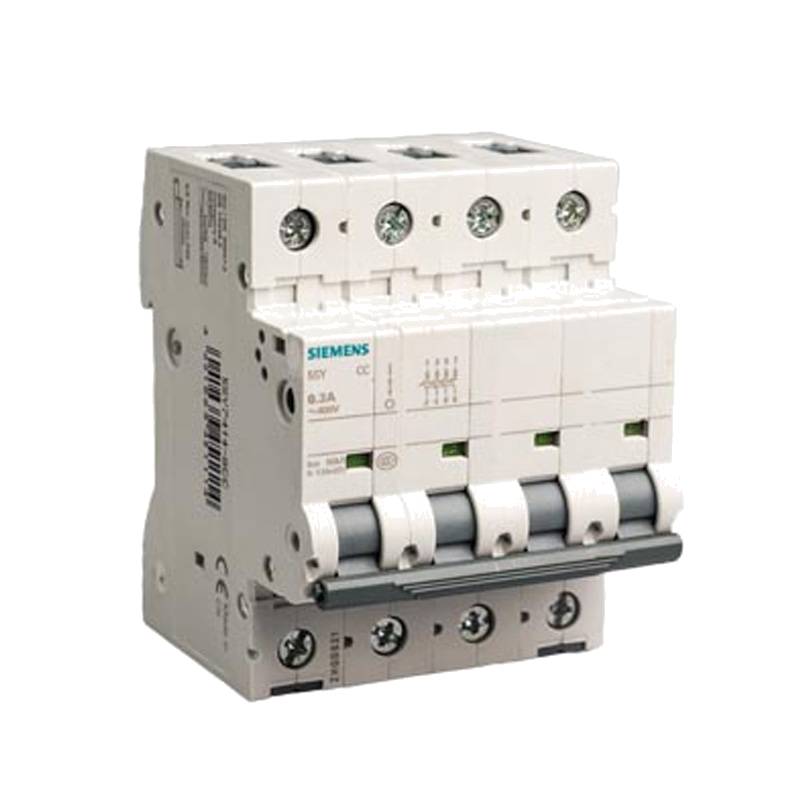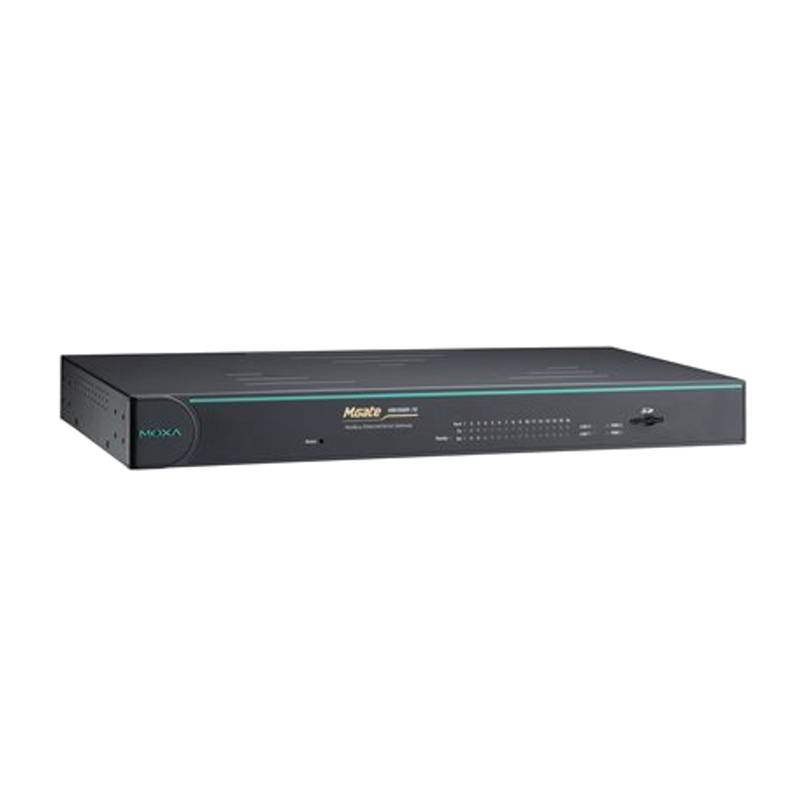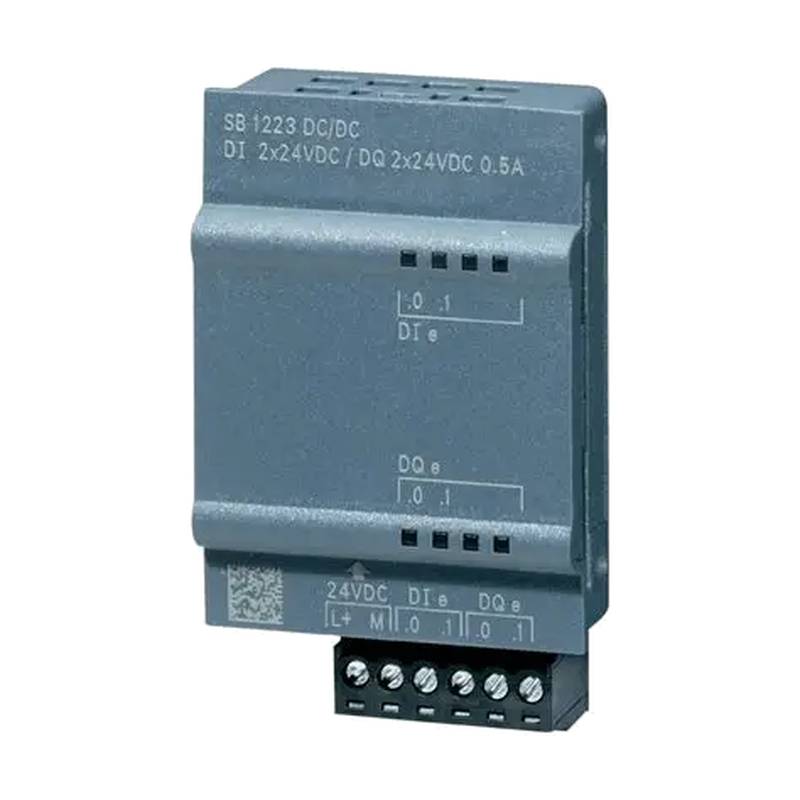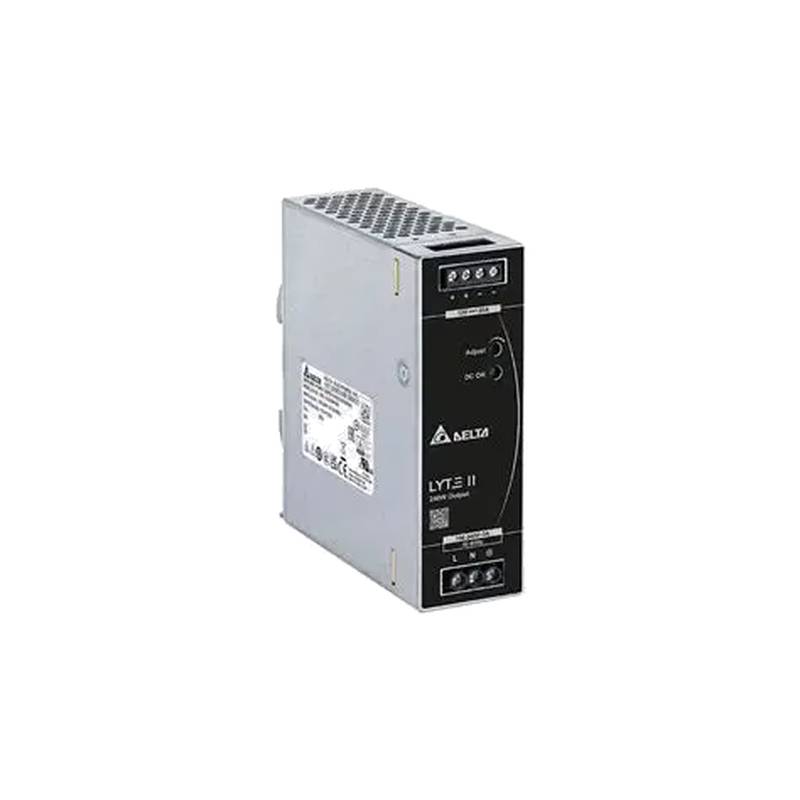
The SCHNEIDER ATV930C11N4, a 110kW variable speed drive (VSD) with a 201A rating, stands as a robust and intelligent solution for demanding pump control applications. Engineered for exceptional performance and reliability, this compact inverter offers advanced features designed to optimize energy efficiency, enhance process control, and simplify integration within industrial automation systems. Key advantages include its high overload capacity, comprehensive protection features, and sophisticated control algorithms tailored for variable torque loads like pumps. The ATV930 series is renowned for its robust construction and advanced thermal management, ensuring consistent operation in harsh environments. Technical parameters highlight its powerful 110kW motor rating, a significant 201A nominal current capacity, and suitability for low-voltage industrial power networks (400V class).
Product Specifications
| Parameter | Value |
| :---------------------- | :------------------------------------- |
| Product Name | SCHNEIDER ATV930C11N4 |
| Rated Power (Motor) | 110 kW |
| Rated Current | 201 A |
| Voltage Rating | 400 V |
| Enclosure Type | IP21 / UL Type 1 |
| Mounting | Wall-mounted |
| Dimensions (H x W x D) | 895 x 532 x 300 mm |
| Weight | 58 kg |
| Operating Temperature | -15°C to +50°C (derating may apply) |
| Control Type | Vector control, V/f control |
| Communication Protocols | Modbus RTU, Modbus TCP, Ethernet/IP etc. |
| Integrated Functions | PID control, Safety functions (STO) |
| | |
Core Features & Market Positioning
The SCHNEIDER ATV930C11N4 distinguishes itself through its exceptional motor control capabilities, particularly its advanced sensorless vector control algorithm, which delivers precise speed and torque regulation even without motor feedback. This feature is critical for pump applications where maintaining accurate flow rates and pressures under varying load conditions is paramount. Its integrated PID controller simplifies the closed-loop control of process variables like pressure or level, eliminating the need for external controllers and reducing system complexity. Furthermore, the drive incorporates Safety Torque Off (STO) functionality, a vital safety feature that guarantees compliance with machinery safety standards. Positioned as a premium industrial automation component, the ATV930 series competes on reliability, advanced functionality, and seamless integration within Schneider Electric's EcoStruxure platform, offering significant advantages in energy savings and operational efficiency over basic VFDs.
Key Application Scenarios
This compact pump control drive inverter is ideally suited for a wide array of demanding industrial applications. Its robust design and advanced control features make it a preferred choice for centrifugal and positive displacement pump control in water and wastewater treatment facilities, ensuring precise flow management and energy optimization. In the oil and gas sector, it provides reliable performance for upstream and downstream pumping operations, managing critical fluid transfer processes. The HVAC industry benefits from its ability to modulate fan and pump speeds, significantly reducing energy consumption in building management systems. Additionally, it finds application in general industrial processes requiring variable speed control for pumping fluids, slurries, or viscous materials, where precise process parameter control is essential for product quality and operational efficiency.
Practical System Integration Guidance
Integrating the SCHNEIDER ATV930C11N4 into an existing system is streamlined by its user-friendly interface and comprehensive connectivity options. For optimal wiring, ensure that motor power cables are appropriately sized and shielded to minimize electromagnetic interference, and connect them to the designated motor terminals (T1, T2, T3). Control wiring, including digital and analog inputs/outputs, should be routed separately from power cables. The drive supports a variety of communication protocols, with Modbus RTU being a common choice for simple integration; configuration typically involves setting communication parameters like device address and baud rate on both the drive and the master controller. Parameter programming is accessed via the drive's integrated keypad or through software tools like SoMove, allowing for detailed customization of motor parameters, control modes, and protection settings to match specific application requirements.
Operation and Risk Mitigation
Safe and efficient operation of the SCHNEIDER ATV930C11N4 relies on adherence to proper operating procedures and understanding of its protection mechanisms. The drive features extensive fault monitoring, including overcurrent, overvoltage, undervoltage, motor overload, and thermal protection, which automatically shut down the motor to prevent damage. For instance, an "Overcurrent" fault (often indicated by fault code "101") typically suggests the motor is drawing more current than permissible, potentially due to a mechanical jam, incorrect motor parameters, or an undersized drive. Resolving this involves checking for mechanical obstructions, verifying motor nameplate data against drive parameters, and ensuring the motor is not operating at a load exceeding the drive's continuous rating. Regular visual inspection of connections and listening for unusual motor noises can help identify potential issues before they trigger a fault.
Scalability & Long-Term Value
The SCHNEIDER ATV930C11N4 offers significant scalability and long-term value, particularly when integrated within the Schneider Electric ecosystem. Its compatibility with various communication protocols, including Ethernet/IP and Modbus TCP, facilitates seamless integration into modern Industrial Internet of Things (IIoT) platforms and SCADA systems. This enables remote monitoring, diagnostics, and predictive maintenance, enhancing overall operational efficiency and reducing downtime. The modular design of the Altivar Process range allows for the addition of option cards for enhanced communication or I/O expansion, ensuring the drive can adapt to evolving system requirements. Furthermore, Schneider Electric's commitment to product lifecycle support and firmware updates ensures that the ATV930C11N4 remains a relevant and high-performing component throughout its operational life, safeguarding investment and ensuring future compatibility.
Frequently Asked Questions
What is the primary application for the SCHNEIDER ATV930C11N4?
The SCHNEIDER ATV930C11N4 is specifically designed for robust pump control in various industrial sectors. Its advanced features optimize energy consumption and process control for variable torque loads. Common uses include water management, HVAC systems, and demanding fluid transfer in manufacturing.
It excels in applications requiring precise flow and pressure regulation, adapting dynamically to changing operational demands. The drive's high overload capacity ensures reliable performance even under challenging load conditions, typical in pumping systems.
This inverter offers a sophisticated solution for modern automation needs, providing efficiency, reliability, and advanced control for critical pumping functions across diverse industrial environments.
How do I wire the SCHNEIDER ATV930C11N4 for a three-phase motor?
For a three-phase motor, connect the motor power leads (typically labeled U, V, W or T1, T2, T3) to the corresponding motor output terminals on the ATV930C11N4 drive. Ensure the motor is correctly phase-sequenced for forward rotation; if it rotates in reverse, swap any two motor leads.
Use appropriately sized and shielded motor power cables to minimize electromagnetic interference and ensure safe operation. It is crucial to properly ground both the drive and the motor according to local electrical codes and manufacturer guidelines.
Always refer to the specific wiring diagrams in the SCHNEIDER ATV930C11N4 installation manual for detailed instructions, terminal designations, and recommended cable types. Proper wiring is essential for performance and safety.
What are the main benefits of using the ATV930C11N4 over a standard motor starter?
The ATV930C11N4 offers significant energy savings by adjusting motor speed to match load requirements, unlike standard starters that run the motor at full speed. This speed modulation drastically reduces power consumption, especially in pump applications.
It provides advanced control capabilities, including precise speed and torque regulation, integrated PID control for process automation, and soft-start/stop functions that reduce mechanical stress on the motor and driven equipment. This extends equipment lifespan.
Furthermore, the drive offers enhanced protection features, diagnostics, and communication capabilities for integration into automated systems, enabling remote monitoring and predictive maintenance, which a basic motor starter cannot provide.
Can the SCHNEIDER ATV930C11N4 be used in hazardous environments?
The standard SCHNEIDER ATV930C11N4 is typically rated for standard industrial environments, often with an IP21 or UL Type 1 enclosure, which provides basic protection against solid objects and limited water ingress. It is not inherently designed for explosive or highly corrosive atmospheres without specific adaptations.
For hazardous environments, Schneider Electric offers specialized drive enclosures or drives with enhanced environmental protection ratings (e.g., higher IP ratings or specific certifications like ATEX). Consult the product documentation or Schneider Electric support for suitable options.
Always ensure the drive's enclosure rating and operating temperature range are compatible with the specific environmental conditions of the installation site to maintain safety and operational integrity.
How do I perform a basic setup or commissioning of the ATV930C11N4?
Basic setup involves accessing the drive's menu via its keypad or a connected PC using software like SoMove. Initially, you must configure fundamental parameters such as motor nominal voltage, frequency, current, and speed from the motor nameplate data.
Next, select the appropriate control mode (e.g., sensorless vector control for pumps) and configure input/output assignments for start/stop commands and speed references. Ensure safety functions like STO are correctly wired and enabled if required.
Finally, perform a motor auto-tuning procedure if available; this calibrates the drive to the specific motor characteristics for optimal performance. Test the drive with a low load first, gradually increasing it while monitoring parameters.
What is the typical overload capacity of the SCHNEIDER ATV930C11N4?
The SCHNEIDER ATV930C11N4 is designed with a robust overload capacity suitable for applications with high starting torque or momentary peak loads, common in pump start-ups. It typically offers a 150% overload for 60 seconds and potentially higher short-term bursts.
This capability ensures that the drive can handle the inrush current during motor start-up and temporary load increases without tripping. It's crucial to refer to the product's specific duty cycle ratings (e.g., Normal Duty vs. Heavy Duty) for precise overload specifications.
Understanding the duty cycle is vital for correct application sizing. For instance, a drive rated for Normal Duty might have different overload capabilities than one specified for Heavy Duty applications like positive displacement pumps.
How can I connect the ATV930C11N4 to a SCADA system?
Connecting the ATV930C11N4 to a SCADA system typically involves using its communication port and a compatible communication protocol. Modbus TCP/IP or Ethernet/IP are common choices for integrating with modern SCADA platforms, providing robust data exchange.
You will need to configure the drive's communication parameters (IP address, subnet mask, etc.) and ensure the SCADA system's communication driver is set up to communicate with the drive. This allows for real-time monitoring of parameters like speed, current, voltage, and fault status.
This integration enables centralized control, data logging for analysis and reporting, and remote diagnostics, significantly enhancing operational oversight and efficiency of the pumping system.
What are common fault codes for the SCHNEIDER ATV930C11N4 and their meanings?
Common fault codes include "OC" (Overcurrent), indicating the motor is drawing excessive current, often due to mechanical issues or incorrect motor parameters. "OV" (Overvoltage) signals that the DC bus voltage has exceeded safe limits.
Another frequent fault is "OH" (Overheating), which signifies that the drive's heatsink temperature is too high, potentially due to inadequate ventilation or operating at high loads. "UV" (Undervoltage) indicates the input power supply voltage is too low.
Each fault code has specific diagnostic steps outlined in the user manual. Addressing these faults requires careful analysis of the system's operating conditions and the drive's configuration to identify and rectify the root cause.
Does the ATV930C11N4 support Safety Torque Off (STO)?
Yes, the SCHNEIDER ATV930C11N4 is equipped with integrated Safety Torque Off (STO) functionality. This is a crucial safety feature that prevents the motor from generating torque, effectively disabling its motion in a safe manner.
STO is achieved by physically interrupting the power stage of the drive, ensuring that the motor cannot be unexpectedly started or moved. It's a standard safety function designed to meet stringent industrial safety regulations, such as IEC 61508 and ISO 13849-1.
Implementing STO requires correct wiring of the safety input terminals and integration with an appropriate safety control system (e.g., safety relays or safety PLC) to ensure a complete safety-rated circuit.
What is the power factor correction capability of the ATV930C11N4?
The ATV930C11N4, like many modern VSDs, does not typically employ active power factor correction at the input stage. However, its sophisticated switching techniques during operation help to minimize harmonic distortion and maintain a relatively good power factor during motor operation.
For applications requiring a high, consistent power factor, external power factor correction equipment (like capacitor banks) may need to be installed. It's important to consult the drive's documentation for specific guidance on harmonic mitigation and power factor considerations.
Schneider Electric also offers active filters or dedicated power factor correction modules that can be integrated into the system for improved power quality and compliance with utility regulations, especially in large installations.














